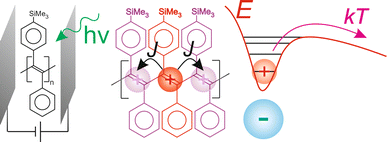Discrete dissociation model of photogenerated inter-chain charge transfer states in external electric fieldMichal Jex, Miroslav Menšík, Petr Toman, and Jiří Pfleger Academy of Sciences of the Czech Republic, Prague 6, Czech Republic
E-mail: michal.jex@fjfi.cvut.cz Abstract: A new theoretical model of photogeneration yield of free charge carriers on the electric field in π-conjugated polymers was introduced. It generalizes the model of Arkhipov et al. (Chem Phys Lett 372:886–892, 2003a) where the dissociation of the inter-chain charge transfer states is controlled by a thermally activated transition from the lowest quantum state over a potential barrier. Contrary to the previous model based on the effective mass approximation, the new model determines the potential and transfer integrals between HOMO orbitals, using quantum chemical methods. The model successfully explained experimental dependences of photogenerated charge yield in poly{1-[4-(trimethylsilyl)phenyl]-2-phenylacetylene} exhibiting a strong sensitivity on electric field strength over a very large interval. This indicates the model applicability for estimation of fill factor in solar cells. The model was found stable toward various distributions of charge transfer states (on-chain delocalization, charge transfer to side groups, helix structure, etc.) and tunneling effects behind potential barrier. Keywords: π-Conjugated polymers ; Charge carrier photogeneration ; Photoconductivity ; Inter-chain charge transfer states ; Charge transfer state dissociation Full paper is available at www.springerlink.com. DOI: 10.1007/s11696-018-0449-z
Chemical Papers 72 (7) 1707–1718 (2018) |
Sunday, November 24, 2024 |
|||
© 2024 Chemical Papers |
||||






